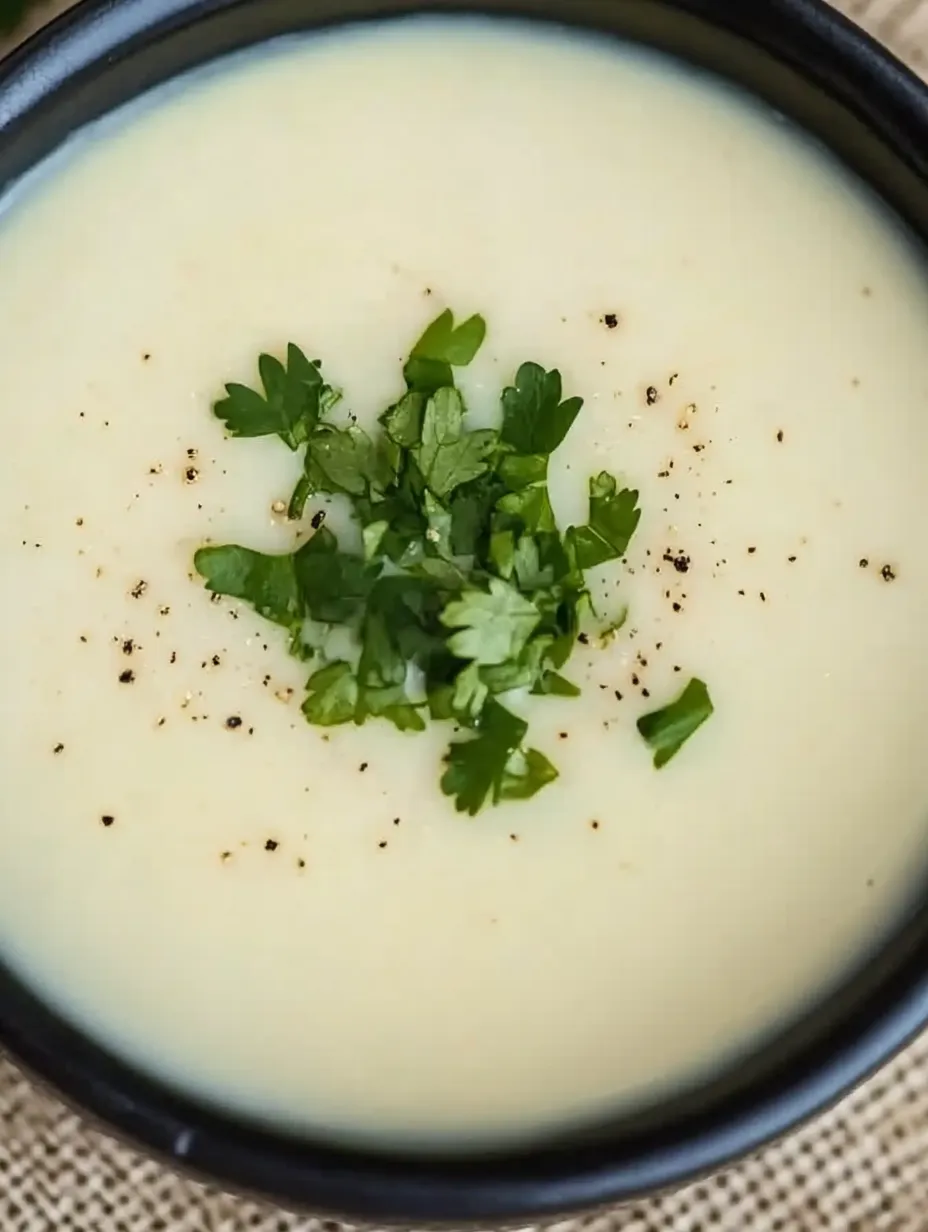 Pin it
Pin it
Silky Leek Soup
This velvety leek soup delivers subtle onion flavor and remarkable creaminess without overwhelming heaviness. The magic lies in properly prepared leeks simmered with potato that naturally thickens the soup while adding body and mouthfeel. I discovered this recipe years ago during a particularly chilly spring when I craved something warming yet lighter than winter stews.
Bowl of Comfort
I first made this soup when experimenting with my farmers market haul one weekend. What began as a practical way to use up extra leeks quickly became a family favorite. My husband, typically indifferent to soup unless it contains chunks of meat, requests this regularly through the cooler months. Even my vegetable skeptic son enjoys a small bowl alongside his grilled cheese.
Essential Ingredients
- Fresh Leeks (3 medium): Deliver delicate onion flavor without harshness, creating the signature taste that defines this soup
- Yellow Potato (1 medium): Creates natural creaminess and body without excessive starch, thickening the soup perfectly while adding subtle sweetness
- Yellow Onion (1 medium): Provides aromatic foundation and depth that enhances the leeks without competing with their delicate flavor
- Chicken Broth (4 cups): Forms the savory liquid base that carries the vegetable flavors while adding complexity and richness
- Fresh Milk (1 cup): Transforms the texture from ordinary to extraordinary with silky smoothness while tempering the intensity
- All Purpose Flour (1/4 cup): Creates the perfect body and mouthfeel through gentle thickening that enhances rather than overwhelms
- Extra Virgin Olive Oil (2 tablespoons): Provides essential fat for sautéing while contributing subtle fruity notes that complement the vegetables
 Pin it
Pin it
Soup Perfection
- Leek Preparation:
- Begin with proper leek preparation, as this foundational step impacts the entire soup. Trim away the dark green tops and root ends, reserving the white and light green portions which offer optimal flavor and texture. Slice these usable portions lengthwise, then crosswise into half inch pieces. Place the chopped leeks in a large bowl of cold water, swishing them thoroughly to release any grit or sand trapped between the layers. Allow them to sit undisturbed for several minutes, letting gravity pull the dirt to the bottom. Lift the leeks out with your hands or a slotted spoon rather than pouring them through a colander, which would reintroduce the settled dirt. Spread on clean kitchen towels or paper towels and pat thoroughly dry before cooking, as excess water will interfere with proper sautéing.
- Flavor Foundation:
- Heat a heavy bottomed soup pot or Dutch oven over medium heat before adding the olive oil. Once the oil shimmers but before it smokes, add the diced onion and a small pinch of salt, which helps draw out moisture. Sauté for 3 to 4 minutes until the onion becomes translucent but not browned. Add the thoroughly dried leeks to the pot and continue cooking for another 5 to 7 minutes, stirring occasionally. This slow cooking develops sweet, complex flavors while softening the vegetables without allowing them to brown, which would introduce bitterness. The vegetables should reduce significantly in volume and become quite soft but maintain their pale color throughout cooking.
- Thickening Technique:
- Once vegetables have softened properly, temporarily remove the pot from heat to add the flour safely without risking lumps. Sprinkle the flour evenly over the vegetable mixture and stir continuously until completely incorporated with no visible dry spots. Return the pot to medium heat and cook this mixture for 2 minutes while stirring constantly. This brief cooking eliminates raw flour taste while creating a roux that will thicken the soup properly. Gradually add the chicken broth in a slow, steady stream while whisking continuously to prevent lumps from forming. Once all broth is incorporated, add the peeled and cubed potato. Bring the mixture to a gentle simmer, then reduce heat to maintain a very gentle bubble without boiling vigorously.
- Final Transformation:
- Cook the soup uncovered for 15 to 20 minutes, or until the potato pieces can be easily pierced with a fork. Remove from heat and allow to cool slightly for safer blending. Use an immersion blender directly in the pot for easiest processing, or carefully transfer portions to a standard blender, filling only halfway and venting the lid properly to prevent pressure buildup. Blend until completely smooth with no visible vegetable pieces remaining. Return the soup to low heat and stir in the milk, allowing it to warm through without boiling which could cause separation. Taste and adjust seasoning with salt and freshly ground pepper as needed. For restaurant quality presentation, ladle into warmed bowls and garnish with a light drizzle of cream, a sprinkle of freshly chopped parsley, or a few homemade croutons for textural contrast.
I particularly appreciate how this soup transforms humble ingredients into something truly elegant. My grandmother always emphasized that good cooking isn't about exotic ingredients but rather treating simple ones with respect. During my college years, this soup became my signature dish for impressing friends on a tight budget. When my daughter began cooking independently, this was the first soup recipe she mastered, appreciating how forgiving it is for beginners while still delivering impressive results.
Ideal Companions
This versatile soup welcomes numerous accompaniments depending on how you're serving it. For a light lunch, pair with a simple salad of bitter greens dressed with vinaigrette to contrast with the soup's creaminess. Crusty artisan bread with good butter makes an essential partner for soaking up every last drop. When serving as a dinner starter, keep portions modest and consider following with a simply prepared protein and vegetable. For heartier appetites, top individual servings with crispy bacon bits, fresh lump crab meat, or sautéed mushrooms. During special occasions, I serve this soup in small cups as an elegant passed appetizer, topped with a tiny sprig of fresh dill and a few drops of good olive oil.
Creative Adaptations
This foundation recipe welcomes numerous variations to suit different tastes or dietary needs. For vegetarians, simply substitute vegetable broth for the chicken broth with minimal flavor impact. Those avoiding gluten can replace the all purpose flour with 2 tablespoons of rice flour or cornstarch dissolved in cold broth before adding. Adding 1/2 cup of diced celery along with the onions introduces subtle complexity, while incorporating 1/4 cup of white wine before adding broth brings pleasant acidity. During spring, a handful of fresh or frozen peas added just before blending introduces color and sweetness. For special occasions, consider finishing with a tablespoon of sherry or replacing 1/4 cup of the milk with heavy cream for extra indulgence. Those preferring texture might reserve a few tablespoons of the sautéed leeks before blending, adding them back to the finished soup.
Storage Wisdom
This soup maintains excellent quality when properly stored, making it ideal for advance preparation. Allow leftover soup to cool completely before transferring to airtight containers, leaving some headspace if freezing to allow for expansion. Refrigerated soup keeps well for 3 to 4 days, developing even deeper flavor after the first day. When reheating, do so gently over medium low heat, stirring occasionally to prevent scorching. Add a small splash of milk or broth if the soup has thickened beyond your preference during storage. For freezing, consider portioning into individual servings for convenient future meals. Frozen soup maintains quality for up to 3 months when properly stored. Thaw overnight in the refrigerator before gently reheating, being careful not to boil vigorously which might cause separation of the milk solids.
 Pin it
Pin it
After preparing this soup countless times, I've come to appreciate its remarkable versatility and forgiving nature. What begins with humble ingredients transforms through simple technique into something truly special that delivers comfort without heaviness. The delicate leek flavor shines through while being accessible even to those who typically avoid onion family vegetables. While restaurant versions often rely on excessive cream and butter for richness, this homemade version achieves luxurious texture through the natural starchiness of potato combined with proper technique. Whether serving for a quiet family dinner or elegant entertaining, this soup never fails to impress while requiring minimal effort and common ingredients found in most kitchens.
Frequently Asked Questions
- → How do I properly clean leeks?
- Leeks often trap dirt between their layers, so proper cleaning is essential. First, trim off the dark green tops and the root end. Then slice the leek lengthwise and rinse under cold running water, fanning out the layers to remove any trapped soil or grit. Alternatively, you can slice the leeks first, then place in a bowl of cold water and swish them around - the dirt will sink to the bottom while the leeks float.
- → Can I make this soup vegetarian?
- Yes, this soup can easily be made vegetarian by substituting vegetable broth for the chicken broth. The flavor profile will be slightly different but equally delicious. All other ingredients in the recipe are already vegetarian-friendly.
- → Can I freeze this leek soup?
- Yes, this soup freezes well, but it's best to freeze it before adding the milk. Freeze the blended soup base for up to 3 months. When ready to serve, thaw completely, reheat gently, and then add the milk. Soups with dairy can sometimes separate when frozen and reheated, which is why adding the milk fresh is recommended.
- → What can I use instead of a hand blender to puree the soup?
- If you don't have a hand blender, you can use a regular blender or food processor. Allow the soup to cool slightly before transferring in batches to your blender. Be careful when blending hot liquids - fill the blender only halfway, hold the lid with a kitchen towel, and start on low speed to prevent hot soup from erupting out of the blender.
- → How can I make this soup more filling?
- To make this soup more substantial, you could add more potatoes for extra heartiness, or include protein like cooked chicken, crispy bacon bits, or white beans. You can also serve it with substantial sides like a grilled cheese sandwich, crusty bread with butter, or a hearty salad with nuts and cheese.
- → Can I use cream instead of milk for a richer soup?
- Absolutely! For a more luxurious version, substitute the milk with half-and-half or heavy cream. This will create a richer, more decadent soup perfect for special occasions. Just remember this will increase the calorie and fat content of the recipe. Start with a smaller amount and add more to taste.
